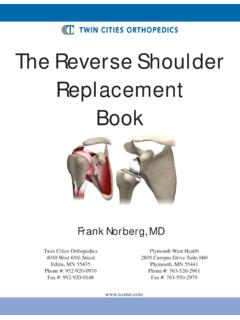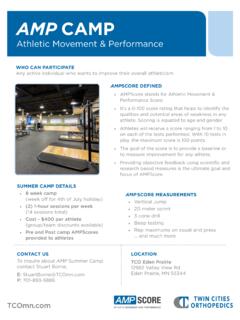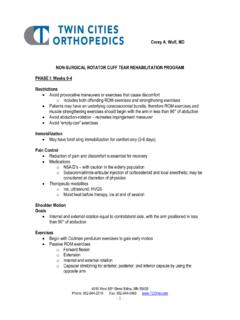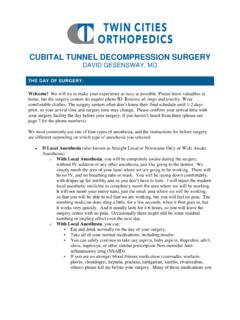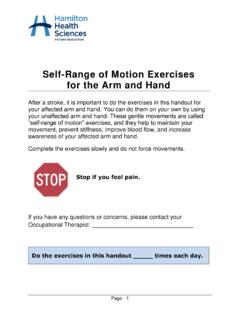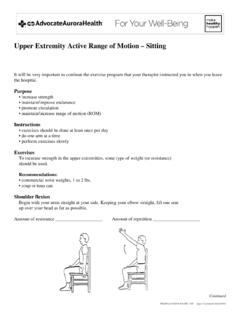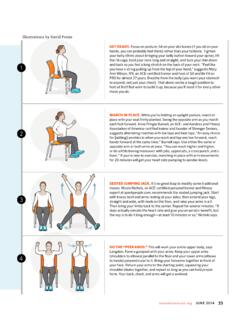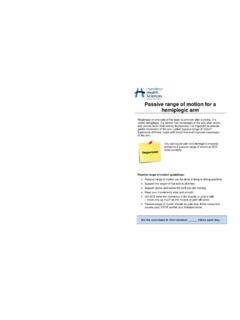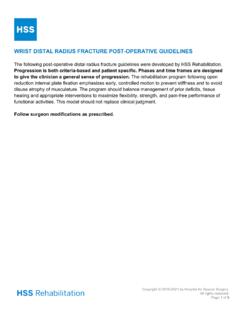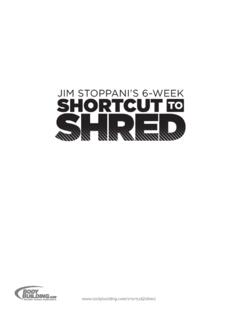Transcription of Rotator Cuff Repair
1 Rotator cuff Repair with Biceps Release/Tenodesis Brian Bjerke, MD Post-Operative Protocol Phase I Maximum Protection (Week 0 to 6) Goals Reduce inflammation Decrease pain Postural education PROM as instructed Restrictions/Exercise Progression Sling x 6 weeks - ultrasling x 4-6 weeks, larger tears may be in ultrasling x 6 weeks then regular sling for 2 additional weeks. Ice and modalities to reduce pain and inflammation. Cervical ROM and basic deep neck flexor activation (chin tucks). Instruction on proper head neck and shoulder (HNS) alignment. Active hand and wrist range of motion. Passive biceps x 6 weeks (AAROM; no release or tenodesis). Active shoulder retraction. Passive range of motion (gradual progression starting at 4 weeks) -No motion x 4 weeks -Flexion 0 -90 from weeks 4-6, then full -External rotation 0 -30 weeks 4-6 then full -Avoid internal rotation (thumb up back) until 8 weeks post-op.
2 Encourage walks and low intensity cardiovascular exercise to promote healing. Manual Intervention STM global shoulder and CT junction. Scar tissue mobilization when incisions are healed. Graded GH mobilizations. ST mobilizations. Phase II Progressive Stretching and Active Motion (Weeks 6 to 8) Goals Discontinue sling except as instruction with large or massive tears. Postural education. Focus on posterior chain strengthening. Begin AROM. P/AAROM: - Flexion 150 + - 30-50 ER @ 0 abduction - 45-70 ER at 70-90 abduction Exercise Progression Progress to full range of motion flexion and external rotation as tolerated. Use a combination of wand, pulleys, wall walks or table slides to ensure compliance. Gradual introduction to internal rotation using shoulder extensions (stick off back).
3 Serratus activation; Ceiling punch (weight of arm) many initially need assistance. Scapular strengthening prone scapular series (rows and I s). Emphasize scapular strengthening under 90 . External rotation on side (no resistance). Gentle therapist directed CR, RS and perturbations to achieve ROM goals. Cervical ROM as needed to maintain full mobility. DNF and proper HNS alignment with all RC/SS exercises. Low to moderate cardiovascular work. May add elliptical but no running. Manual Intervention STM global shoulder and CT junction. Scar tissue mobilization. Graded GH mobilizations. ST mobilizations. Gentle CR/RS to gain ROM while respecting repaired tissue. Phase III Strengthening Phase (Weeks 8 to 12) Goals 90% passive ROM, 80-90% AROM by 12 weeks.
4 Larger tears and patients with poor tissue quality will progress more slowly. Normalize GH/ST arthrokinematics. Activate RC/SS with isometric and isotonic progression. Continue to emphasize posterior chain strengthening but introduce anterior shoulder loading. Exercise Progression Passive and active program pushing for full flexion and external rotation. Continue with stick off the back progressing to internal rotation with thumb up back and sleeper stretch. Add resistance to ceiling punch. Sub-maximal Rotator cuff isometrics (no pain). Advance prone series to include T s. Add rows with weights or bands. Supine chest-flys providing both strength and active anterior shoulder stretch. Supine (adding weight as tolerated) progressing to standing PNF patterns.
5 Seated active ER at 90/90. Biceps and triceps PRE. Scaption; normalize ST arthrokinematics. 10 weeks; add quadruped or counter weight shift. Therapist directed RS and perturbations in quadruped bilateral progressing to unilateral-tri pod position. Manual Intervention STM and Joint mobilization to CT junction, GHJ and STJ as needed. CR/RS to gain ROM while respecting repaired tissue. Manual perturbations. PNF patterns. Phase IV Advanced Strengthening and Plyometric Drills PRE/PSE (weeks 12-20) Full range of motion all planes emphasize terminal stretching with cross arm, TUB, triceps, TV, sleeper and door/pec stretch. Begin strengthening at or above 90 with prone or standing Y s, D2 flexion pattern and 90/90 as scapular control and ROM permit.
6 Patient health, physical condition and goals/objectives will determine if strengthening above 90 is appropriate. Add lat pulls to gym strengthening program; very gradual progression with pressing and overhead activity. Continue with closed chain quadruped perturbations; add open chain as strength permits. Progress closed kinetic chain program to include push-up progression beginning with counter, knee then gradual progression to full as appropriate. Initiate plyometric and rebounder drills as appropriate. RTS program (weeks 20 to 24) Continue to progress RC and scapular strengthening program as outlined. Advance gym strengthening program. RTS testing for interval programs (golf, tennis etc.). Microfet testing as appropriate. Follow-up examination with the physician (6 months) for release to full activity.
7 Manual Intervention STM and Joint mobilization to CT junction, GHJ and STJ as needed. CR/RS to gain ROM while respecting repaired tissue. Manual perturbations. PNF patterns. Please have Physical Therapist call Dr. Bjerke with any questions. TCO - Edina: 952-456-7000.

